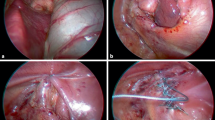Abstract
Purpose
Gastroesophageal reflux disease (GERD) is one of the concomitant problems in infants with congenital diaphragmatic hernia (CDH). We assessed risk factors of GERD in CDH patients.
Methods
The retrospective observational study for CDH infants was conducted. Cases of CDH who were born between January 2006 and December 2010, were operated in the 9 participating institutions, and survived to discharge were included. Completion of medical therapy for GERD and incidence of surgery were primary outcomes. Kaplan–Meier survival analysis and Cox proportional hazards regression were used.
Results
In 182 cases of CDH, the medical therapies for GERD were performed in 23.8 % (40/168), and were completed in 60.0 % (24/40). Prenatal detection of CDH (HR 5.87, CI 1.6–18.8, p = 0.012) and tube feeding at discharge (HR 5.04, 95 % CI 1.3–33.1, p = 0.016) were significantly correlated with unsuccessful weaning from medical therapy. Surgery for GERD was performed in 10.7 % (18/169). Gestational age (HR 4.78, 95 % CI 1.5–21.1, p = 0.006) and diaphragmatic defect of more than 75 % (HR 4.3, 95 % CI 1.6–12.9, p = 0.005) were significantly correlated with need for antireflux surgery.
Conclusion
Diaphragmatic defect of more than 75 % was risk factor of future need for antireflux surgery.


Similar content being viewed by others
References
Bagolan P, Morini F (2007) Long-term follow up of infants with congenital diaphragmatic hernia. Semin Pediatr Surg 16:134–144. doi:10.1053/j.sempedsurg.2007.01.009
Leeuwen L, Fitzgerald DA (2014) Congenital diaphragmatic hernia. J Paediatr Child Health. doi:10.1111/jpc.12508
Lightdale JR, Gremse DA, Section on Gastroenterology, Hepatology, and Nutrition (2013) Gastroesophageal reflux: management guidance for the pediatrician. Pediatrics 131:e1684–e1695. doi:10.1542/peds.2013-0421
Nagaya M, Akatsuka H, Kato J (1994) Gastroesophageal reflux occurring after repair of congenital diaphragmatic hernia. J Pediatr Surg 29:1447–1451
Sigalet DL, Nguyen LT, Aldolph V, Laberge JM, Hong AR, Guttman FM (1994) Gastroesophageal reflux associated with large diaphragmatic hernias. J Pediatr Surg 29:1262–1265. doi:10.1016/0022-3468(94)90819-2
Muratore CS, Utter S, Jaksic T, Lund DP, Wilson JM (2001) Nutritional morbidity in survivors of congenital diaphragmatic hernia. J Pediatr Surg 36:1171–1176. doi:10.1053/jpsu.2001.25746
Diamond IR, Mah K, Kim PC, Bohn D, Gerstle JT, Wales PW (2007) Predicting the need for fundoplication at the time of congenital diaphragmatic hernia repair. J Pediatr Surg 42:1066–1070. doi:10.1016/j.jpedsurg.2007.01.046
Su W, Berry M, Puligandla PS, Aspirot A, Flageole H, Laberge JM (2007) Predictors of gastroesophageal reflux in neonates with congenital diaphragmatic hernia. J Pediatr Surg 42:1639–1643. doi:10.1016/j.jpedsurg.2007.05.016
Peetsold MG, Kneepkens CM, Heij HA, IJsselstijn H, Tibboel D, Gemke RJ (2010) Congenital diaphragmatic hernia: long-term risk of gastroesophageal reflux disease. J Pediatr Gastroenterol Nutr 51:448–453. doi:10.1097/MPG.0b013e3181d1b149
Kieffer J, Sapin E, Berg A, Bargy BF, Helardot PG (1995) Gastroesophageal reflux after repair of congenital diaphragmatic hernia. J Pediatr Surg 30:1330–1333. doi:10.1016/0022-3468(95)90497-2
Kamiyama M, Kawahara H, Okuyama H, Oue T, Kuroda S, Kubota A, Okada A (2002) Gastroesophageal reflux after repair of congenital diaphragmatic hernia. J Pediatr Surg 37:1681–1684. doi:10.1053/jpsu.2002.36693
Abdullah F, Zhang Y, Sciortino C, Camp M, Gabre-Kidan A, Price MR, Chang DC (2009) Congenital diaphragmatic hernia: outcome review of 2,173 surgical repairs in US infants. Pediatr Surg Int 25:1059–1064. doi:10.1007/s00383-009-2473-0
Campanozzi A, Boccia G, Pensabene L, Panetta F, Marseglia A, Strisciuglio P, Barbera C, Magazzù G, Pettoello-Mantovani M, Staiano A (2009) Prevalence and natural history of gastroesophageal reflux: pediatric prospective survey. Pediatrics 123:779–783. doi:10.1542/peds.2007-3569
Koivusalo AI, Pakarinen MP, Lindahl HG, Rintala RJ (2008) The cumulative incidence of significant gastroesophageal reflux in patients with congenital diaphragmatic hernia-a systematic clinical, pH-metric, and endoscopic follow-up study. J Pediatr Surg 43:279–282. doi:10.1016/j.jpedsurg.2007.10.014
Nagata K, Usui N, Kanamori Y, Takahashi S, Hayakawa M, Okuyama H, Inamura N, Fujino Y, Taguchi T (2013) The current profile and outcome of congenital diaphragmatic hernia: a nationwide survey in Japan. J Pediatr Surg 48:738–744. doi:10.1016/j.jpedsurg.2012.12.017
Usui N, Kitano Y, Okuyama H, Saito M, Morikawa N, Takayasu H, Nakamura T, Hayashi S, Kawataki M, Ishikawa H, Nose K, Inamura N, Masumoto K, Sago H (2011) Reliability of the lung to thorax transverse area ratio as a predictive parameter in fetuses with congenital diaphragmatic hernia. Pediatr Surg Int 27:39–45. doi:10.1007/s00383-010-2725-z
Dariel A, Rozé JC, Piloquet H, Podevin G, French CDH Study Group (2010) Impact of prophylactic fundoplication on survival without growth disorder in left congenital diaphragmatic hernia requiring a patch repair. J Pediatr 157:688–690
Maier S, Zahn K, Wessel LM, Schaible T, Brade J, Reinshagen K (2011) Preventive antireflux surgery in neonates with congenital diaphragmatic hernia: a single-blinded prospective study. J Pediatr Surg 46:1510–1515. doi:10.1016/j.jpedsurg.2011.03.085
Acknowledgments
This work was supported by a grant from the Ministry of Health, Labor and Welfare of Japan (Health and Labor Sciences Research Grants for Research on Intrac Diseases). The authors gratefully acknowledge the contributions of all the pediatric surgery and/or tertiary perinatal care centers for the collection of data for this study. We are grateful to Dr. Yasunori Sato (Clinical Research Center, Chiba University Hospital) for his supervising in statistical analyses.
Conflict of interest
The authors declare that they have no conflicts of interest.
Author information
Authors and Affiliations
Consortia
Corresponding author
Rights and permissions
About this article
Cite this article
Terui, K., Taguchi, T., Goishi, K. et al. Prognostic factors of gastroesophageal reflux disease in congenital diaphragmatic hernia: a multicenter study. Pediatr Surg Int 30, 1129–1134 (2014). https://doi.org/10.1007/s00383-014-3594-7
Accepted:
Published:
Issue Date:
DOI: https://doi.org/10.1007/s00383-014-3594-7




